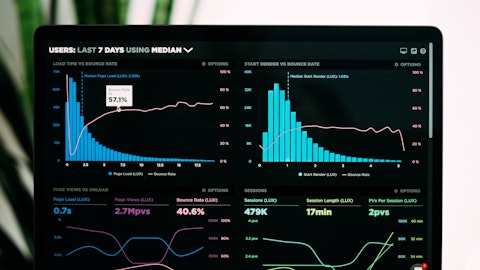So, we continue to look at is the portfolio the right thing and is there value to be unlocked? But to date, we have not seen that there’s a big opportunity to break up the portfolio and drive value because we believe the dissynergies and the tax impact would overwhelm any value we would get from a major divestiture. That being said, we also very clearly said that we don’t think 80 brands is the right answer. And so, as part of the strategy, we said we’re going to prioritize the top 25 brands because they represent 90% of the sales and profit of the Company. We are moving at pace since we announced that strategy in June. And as I mentioned in my prepared remarks, we expect to be down from 80 brands down to 60 by the end of this year. So, that’s already a meaningful reduction in the number of brands in the portfolio, and we think we’ll continue to reduce the number of brands over time.
As we look to how are we reducing the number of brands in the portfolio, largely what we’re doing is we’re converting shelf space that we have on these smaller, less consumer-relevant brands into shelf space on our bigger, more profitable, more consumer-relevant brands. But it takes a little bit of time to do that because retailers reset their shelving typically on an annual basis, and we don’t want to create holes across shelving. And so, we’ve worked up a plan to sort of migrate this shelf space over time from these small brands that we will be exiting into a more streamlined portfolio focused on the top 25.
Operator: And our next question comes from the line of Bill Chappell with Truist Securities.
Bill Chappell: Just kind of keeping it, as it seems to be, on the kind of a high-level conversation this morning. This is now, I guess, kind of the third cut to top line this year and I know that things change with your kind of new outlook midyear. But trying to understand how forecastable your business is right now with — and the kind of merits of doing so many things to try to rightsize the ship when the macro environment is so kind of volatile. And when I say that, I mean, you talked about lowering the number of brands by 20, replacing, I think, a third of the brand managers in the past six months, SKU reduction, Project Ovid, project — there are a couple of other projects in there. And at the time when it doesn’t seem like anyone in the categories you play in can really forecast kind of post-pandemic recovery or new normal.
So, I’m just — maybe you could touch on, do you worry that you’re doing too much or that with all these changes happening, that forecastability isn’t going to be that great for six months until we kind of see how things sit, or is this just something you had to do and it’s kind of a rip the band-aid type moment?
Chris Peterson: Yes, it’s a good question. It’s one that we talk a lot about with the Board and with the management team inside the Company. If you look at the core sales growth of minus 9% in Q3, and I think we had guided down 5% to 7%, so we were 3 points off at the midpoint of the range versus the actual, that 3-point miss was really entirely driven by market growth, which came in weaker than we expected. And that gets to your point of it’s a challenging environment to forecast the market and consumer offtake right now. That being said, we believe, from the capability assessment work that we’ve done and the strategy that we put in place, that we need to improve these capabilities because at some point, this market will turn and the macro environment will not be as negative as it is now.
And we want to make sure when that happens that we are fully positioned to take advantage of that with a portfolio of leading brands that have the ability to consistently grow market share and drive market growth in what eventually will be a better macro environment. But, we recognize that the macro environment right now is very difficult to forecast. We’re trying to run the business on a scenario planning basis with wider ranges of possible outcomes, given that dynamic. But it doesn’t cause us to slow down on the capability improvement actions that we need to drive because we believe that those need to happen irrespective of the macro environment.
Bill Chappell: Got it. Is that — I mean, when I’m listening to the initiatives and stuff like that, I mean, the way you look at it is, they’ve all been announced and in our process. It’s not you’re continuing to look for new initiatives or new ways to change the business. It’s, we just got to keep pushing forward with the original kind of reorg.
Chris Peterson: That’s exactly right. So there’s — from the capability assessment, which was comprehensive that led to the strategy, there’s been no change in the strategy or in the initiatives that we’re driving to try to drive the capability improvement. And many of them are now well underway. Some of them have actually already been completed, not all, but it’s not that we’re adding new things on to the list. We’re driving the plan that we put in place as part of the June strategy review.
Bill Chappell: Got it. And then, one just follow-up on the Writing instruments, I mean, that was a category that had at least low to mid-single-digit growth for many years prior and going into the pandemic. Obviously, the pandemic changed everything with back-to-school and what have you. As we’re getting back to a more normalized environment, is this a long-term mid-single-digit growth or low to mid-single-digit growth category, or is it more mature now and it’s maybe not as opportunistic as it used to be?
Chris Peterson: Yes. We’ve looked at that, at the Writing category growth over the last 5 years, over the last 10 years, over the last 20 years. And over — if you normalize out sort of the COVID blip, it’s been a category that’s been growing kind of low single digits on a global basis. So, we think that that’s the right place for it to be. I don’t think it’s a mid-single-digit growing category. I think it’s a low-single-digit growing category. And that’s our view of what we think is likely on a normalized basis going forward.
Operator: And our next question comes from the line of Peter Grom with UBS.
Peter Grom: So, I appreciate all the commentary on ‘24 and I’m sure we’ll get more concrete guidance in February. But is there any way to frame the degree of margin expansion that you’re kind of expecting just because — should we expect kind of the 4Q exit rate, which is pretty substantial to continue? Should it be a bit more subdued than that? Just because given the top line commentary, higher interest, tax rate, if it’s less robust, that would imply a pretty substantial step down in EPS. So, I’m not trying to pin down guidance or anything but just it would be helpful to just try to understand directionally how we should be thinking about it.
Mark Erceg: Yes. Let me offer a few thoughts as it relates to that and maybe I can even reinforce some of the commentary about the current year gross margin progression. We’re really excited by what’s happening on the gross margin front, right? We said we have to improve the structural economics of the business and we’ve been getting after that in quick order here. And you’re seeing that in the fact that we’ve improved sequentially from Q1 to Q2, Q2 to Q3, and we’re calling for a very large continued progression on gross margin from Q3 to Q4 of this year, which we do think will put us into a good launchpad going into the following year. It’s notable that this is the first time gross margin expanded since the second quarter of ‘21.





